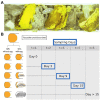Solitary bee larvae modify bacterial diversity of pollen provisions in the stem-nesting bee, Osmia cornifrons (Megachilidae)
- PMID: 36699601
- PMCID: PMC9868615
- DOI: 10.3389/fmicb.2022.1057626
Solitary bee larvae modify bacterial diversity of pollen provisions in the stem-nesting bee, Osmia cornifrons (Megachilidae)
Abstract
Microbes, including diverse bacteria and fungi, play an important role in the health of both solitary and social bees. Among solitary bee species, in which larvae remain in a closed brood cell throughout development, experiments that modified or eliminated the brood cell microbiome through sterilization indicated that microbes contribute substantially to larval nutrition and are in some cases essential for larval development. To better understand how feeding larvae impact the microbial community of their pollen/nectar provisions, we examine the temporal shift in the bacterial community in the presence and absence of actively feeding larvae of the solitary, stem-nesting bee, Osmia cornifrons (Megachilidae). Our results indicate that the O. cornifrons brood cell bacterial community is initially diverse. However, larval solitary bees modify the microbial community of their pollen/nectar provisions over time by suppressing or eliminating rare taxa while favoring bacterial endosymbionts of insects and diverse plant pathogens, perhaps through improved conditions or competitive release. We suspect that the proliferation of opportunistic plant pathogens may improve nutrient availability of developing larvae through degradation of pollen. Thus, the health and development of solitary bees may be interconnected with pollen bacterial diversity and perhaps with the propagation of plant pathogens.
Keywords: Megachilidae; bees; brood cell; development; larvae–development; microbiome; plant pathogen; pollen.
Copyright © 2023 Kueneman, Gillung, Van Dyke, Fordyce and Danforth.
Conflict of interest statement
The authors declare that the research was conducted in the absence of any commercial or financial relationships that could be construed as a potential conflict of interest.
Figures




Similar articles
-
Environmentally acquired gut-associated bacteria are not critical for growth and survival in a solitary bee, Megachile rotundata.Appl Environ Microbiol. 2024 Sep 18;90(9):e0207623. doi: 10.1128/aem.02076-23. Epub 2024 Aug 13. Appl Environ Microbiol. 2024. PMID: 39136489 Free PMC article.
-
More than mesolectic: Characterizing the nutritional niche of Osmia cornifrons.Ecol Evol. 2023 Oct 20;13(10):e10640. doi: 10.1002/ece3.10640. eCollection 2023 Oct. Ecol Evol. 2023. PMID: 37869440 Free PMC article.
-
Do amino and fatty acid profiles of pollen provisions correlate with bacterial microbiomes in the mason bee Osmia bicornis?Philos Trans R Soc Lond B Biol Sci. 2022 Jun 20;377(1853):20210171. doi: 10.1098/rstb.2021.0171. Epub 2022 May 2. Philos Trans R Soc Lond B Biol Sci. 2022. PMID: 35491605 Free PMC article.
-
Developing and establishing bee species as crop pollinators: the example of Osmia spp. (Hymenoptera: Megachilidae) and fruit trees.Bull Entomol Res. 2002 Feb;92(1):3-16. doi: 10.1079/BER2001139. Bull Entomol Res. 2002. PMID: 12020357 Review.
-
Microbes, the 'silent third partners' of bee-angiosperm mutualisms.Trends Ecol Evol. 2024 Jan;39(1):65-77. doi: 10.1016/j.tree.2023.09.001. Epub 2023 Nov 6. Trends Ecol Evol. 2024. PMID: 37940503 Review.
Cited by
-
Direct and indirect effects of land use on microbiomes of trap-nesting solitary bee larvae and nests.Front Microbiol. 2025 Jan 9;15:1513096. doi: 10.3389/fmicb.2024.1513096. eCollection 2024. Front Microbiol. 2025. PMID: 39845038 Free PMC article.
-
Fungicide ingestion reduces net energy gain and microbiome diversity of the solitary mason bee.Sci Rep. 2024 Feb 8;14(1):3229. doi: 10.1038/s41598-024-53935-y. Sci Rep. 2024. PMID: 38332135 Free PMC article.
-
Composition and Diversity of Gut Bacterial Community in Different Life Stages of Osmia excavata Alfken (Hymenoptera: Megachilidae).Microorganisms. 2024 Aug 19;12(8):1709. doi: 10.3390/microorganisms12081709. Microorganisms. 2024. PMID: 39203551 Free PMC article.
-
Acetamiprid Exposure Disrupts Gut Microbiota in Adult and Larval Worker Honeybees (Apis mellifera L.).Insects. 2024 Nov 26;15(12):927. doi: 10.3390/insects15120927. Insects. 2024. PMID: 39769529 Free PMC article.
-
Environmentally acquired gut-associated bacteria are not critical for growth and survival in a solitary bee, Megachile rotundata.Appl Environ Microbiol. 2024 Sep 18;90(9):e0207623. doi: 10.1128/aem.02076-23. Epub 2024 Aug 13. Appl Environ Microbiol. 2024. PMID: 39136489 Free PMC article.
References
-
- Benjamini Y., Hochberg Y. (1995). Controlling the false discovery rate: a practical and powerful approach to multiple testing. J. R. Stat. Soc. Ser. B Methodol. 57, 289–300.
LinkOut - more resources
Full Text Sources

